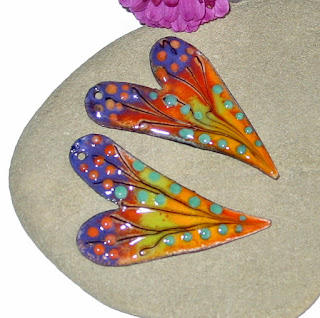I came up with these at Thanksgiving, and they seem to be gaining popularity, so I thought I'd put together a quick tutorial.
I use a graduated round bead roller for size consistency, it really helps.
Wire is 18g copper, readily available at Monsterslayer, Rio, etc
Wire holding tool is a pin vise, you really need a hollow one, so that you can slide the wire all the way in.
You'll need to be working on about an inch of wire, so you can work without bending it.
You'll also want a pair of mashers, and your pliers of choice for setting murrini and pulling tips.
For this wing, I used opal yellow, Clio, and crystal clear, plus black filigrana (or intense black) stringer, white stringer,and murrini.
Start with a small opal yellow gather on the end of the wire (which was heated to a glow before applying glass), and make sure it fits one of the 2 smallest cavities on the beadroller. Round it out, and encase thinly with Clio.
Round that out in the roller, and reduce.
Encase with clear beneath the flame. Back to the roller, round it out again, and remember what cavity your final piece fits.
Now for the fun part.
Flatten the round and pull the tip out, either with pliers or with a rod.
Imagine the wire is at 12 o'clock, you want to attach on or grab at 4/5 or 7/8 o'clock, just off center.
Pull out gently, curving slightly towards 6 o'clock. You want to wind up with a paisley type shape. ( The example isn't as curved as it should be.)
Flatten again gently with your mashers.
Now to decorate----the base of the piece is the base of the wing, so add your detailing accordingly.
I use several older Dover books on butterflies, and there are tons of photos online and at the library--you just need to find a style that works for you in glass.
I do decorate both sides, there are more designing options that way.
I tend to draw a single line along the longer edge, then draw veins off of that. You can apply a murrini at the base like the photo, or a bubble of silver glass, anything you like.
In my opinion, the dots really add a lot, I like white because it reads so well from a distance.
On the final example, I added edge detailing with a razor tool for visual interest.
Another variation: add a black tip to your final gather, it should cover the bottom third or so of the round. When you flatten, it gives a nice black edge to add detail on.
Saturday, December 31, 2016
Wednesday, December 21, 2016
Saturday, December 3, 2016
Wednesday, November 16, 2016
Subscribe to:
Posts (Atom)



















































